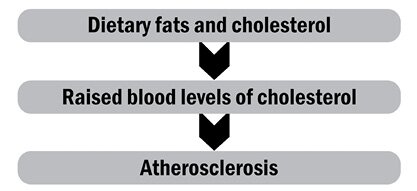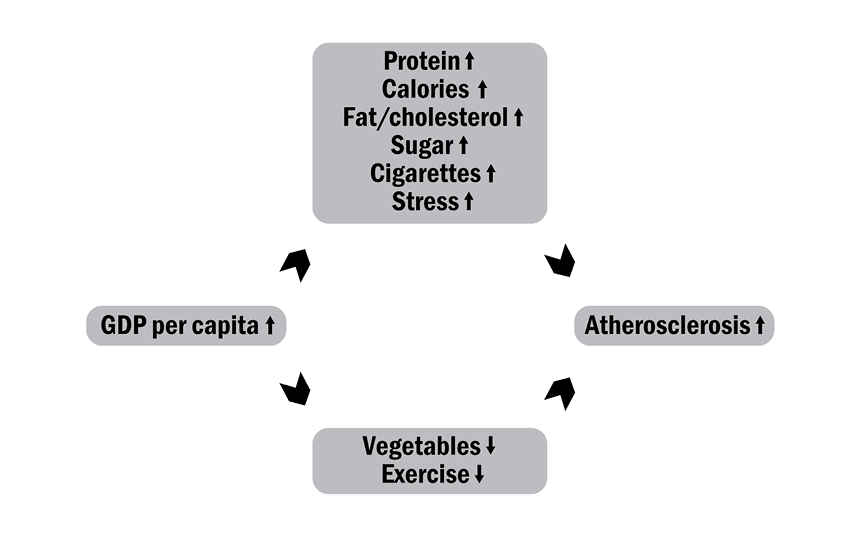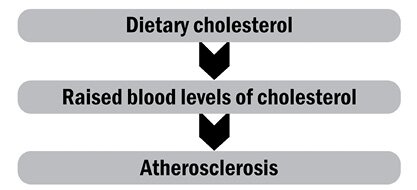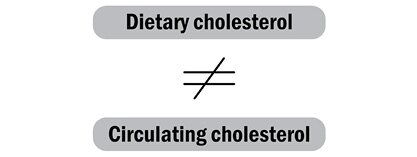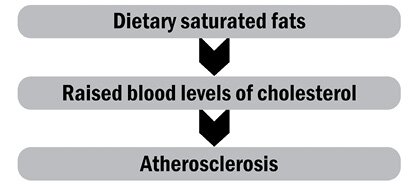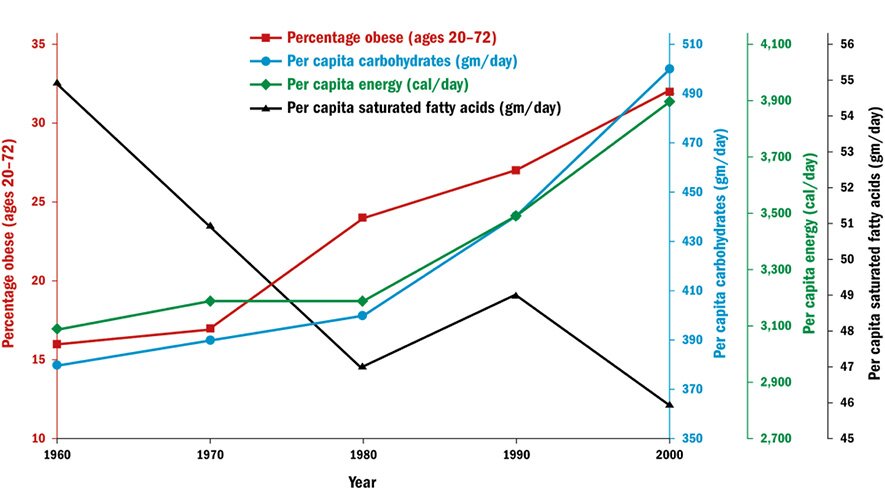Indeed, Marion Nestle’s book Food Politics: How the Food Industry Influences Nutrition and Health, was first published in 2002; it is now in its third edition, and it has been cited no fewer than 2,250 times, yet the food industry still influences the federal government’s advice. Thus the New York Times for January 18, 2016, reported that the early drafts of the 2015–2020 Guidelines confirmed that red and processed meats increase the risks of developing bowel and other cancers, but — following the lobbying of Congress by the National Cattlemen’s Beef Association — the reference was removed from the final version.61
The problem of poor science is aggravated in food because of the vast weight of papers (containing highly selective information and highly selective statistics) that are published in distinguished journals by food companies themselves. A recent survey showed, for example, that reviews of the literature authored by scientists with financial links to the sugar industry were five times less likely to conclude that sugar aggravated obesity or weight gain than did reviews authored by independent scientists.62 Where a field of research such as food science can be dominated by producers’ research, therefore, it can be doubly difficult to determine the various sources of bias. And the bias can be secret: we now know, for example, that Mark Hegsted, the Senate committee’s chief scientific adviser, was being secretly paid by the sugar producers to condemn fat and exonerate sugar and carbohydrates.63
Governments may be institutionally incapable of providing disinterested advice for at least four reasons. First, the scientists themselves may be divided, and by choosing one argument over another, the government may be making a mistake. Second, by abusing the precautionary principle, the government may be biasing its advice away from objectivity to risk-avoidance long before all the actual risks have been calculated. Third, because of public pressure, it may offer premature advice. And fourth, its advice will be distorted by lobbying.
Congress has lost patience with official dietary advice, so it commissioned the National Academy of Medicine to review “the entire process used” to generate the official guidelines, although unfortunately the review was limited only to methodology and not results.64 But why should the federal government issue health advice at all? The general public, sadly, will give greater credence to federal government pronouncements than the science can bear, and it would surely be healthier to promote a free market in research ideas. There are a large number of scientific institutions qualified to give advice on food, and it would surely be healthier for the public to be exposed directly to their disagreements rather than for the federal government to proselytize an apparent consensus that, in reality, is only partial and selective.
The tragedy is that food science is, because of the power and money of its commercial sponsors, deeply flawed, yet government — by inserting its own biases — has only amplified that science’s faults. Society does need a truly independent, truly high-powered entity to interrogate food science’s output, but that will have to be sought among the ranks of people like Gary Taubes, who have made a career of probing the biases of science.
There is a tradition of politicians involving themselves in science. From William Jennings Bryan’s attack on evolutionary theory in the Scopes Trial, to Al Gore and Donald Trump distorting modern climate science, politicians inevitably politicize science and almost always get it wrong; Senator McGovern’s actions were only one example of the many that have damaged the credibility of both science and politics. More than 200 years ago Thomas Jefferson warned politicians particularly not to engage with dietary science, and we need to reheed his warning.65
1 Select Committee on Nutrition and Human Needs, United States Senate, Dietary Goals for the United States (Washington: Government Printing Office, 1977), p. 1, https://archive.org/details/CAT10527234.
2Dietary Goals for the United States, p. v.
3Dietary Goals for the United States, p. 12.
4 U.S. Department of Health, Education, and Welfare, Vital Statistics of the United States, 1968: Volume II—Mortality, Part A (Rockville, MD: Public Health Service, 1972), pp. 1–6, www.cdc.gov/nchs/data/vsus/mort68_2a.pdf.
5 Leon Michaels, “Aetiology of Coronary Artery Disease: An Historical Approach,” British Heart Journal 28, no. 2 (1966): 258–64, doi:10.1136/hrt.28.2.258.
6 Ancel Keys, “Atherosclerosis: A Problem in Newer Public Health,” Journal of the Mount Sinai Hospital 2 (July and August 1953): 118–39.
7 Nina Teicholz, Big Fat Surprise (London: Scribe Publications, 2014), p. 36.
8 Study Group on Atherosclerosis and Ischaemic Heart Disease, Proceedings 117 (Geneva: World Health Organization, 1957).
9 Ancel Keys and Joseph T. Anderson, Symposium on Atherosclerosis: Proceedings (Washington: National Academy of Sciences–National Research Council, 1954). Quoted in Jacob Yerushalmy and Herman E. Hilleboe, “Fat in the Diet and Mortality from Heart Disease: A Methodological Note,” New York State Journal of Medicine 57, no. 14 (1957): 2343–54.
10 John Yudkin, Pure, White and Deadly, 2nd ed. (London: Penguin, 2012), p. 86; and John Yudkin, “Diet and Coronary Thrombosis: Hypothesis and Fact,” Lancet II (1957): 155.
11 Yudkin, Pure, White and Deadly, p. 63.
12 Edward H. Ahrenset et al., “Dietary Control of Serum Lipids in Relation to Atherosclerosis,” Journal of the American Medical Association 164, no. 17 (August 24, 1957): 1905-11, doi:10.1001/jama.1957.62980170017007d.
13 Carmel McCoubrey, “Edward Ahrens Cholesterol Researcher, Is Dead at 85,” New York Times, December 16, 2000, http://www.nytimes.com/2000/12/16/us/edward-ahrens-cholestrol-researcher-is-dead-at-85.html.
14 George V. Mann, “Diet-Heart: End of an Era,” New England Journal of Medicine 297, no. 12 (October 1977): 644–50, doi:10.1056/nejm197709222971206.
15 A. E. Bennett et al., “Sugar Consumption and Cigarette Smoking,” Lancet 295, no. 7655 (May 16, 1970): 1011–14, doi:10.1016/s0140-6736(70)91147–5.
16 Gerald Finking and Hartmut Hanke, “Nikolaj Nikolajewitsch Anitschkow (1885–1964) Established the Cholesterol-Fed Rabbit as a Model for Atherosclerosis Research,” Atherosclerosis 135, no. 1 (1997): 1–7, doi:10.1016/s0021-9150(97)00161–5.
17 Ancel Keys et al., “Effects of Diet on Blood Lipids in Man, Particularly Cholesterol and Lipoproteins,” Clinical Chemistry 1, no. 1 (1955): 34–52, http://clinchem.aaccjnls.org/content/clinchem/1/1/34.full.pdf.
18 U.S. Department of Agriculture and Department of Health and Human Services, Scientific Report of the 2015 Dietary Guidelines Advisory Committee (Washington: USDA and HHS, 2015), p. 17, https://health.gov/dietaryguidelines/2015-scientific-report/PDFs/Scientific-Report-of-the-2015-Dietary-Guidelines-Advisory-Committee.pdf.
19 Gary Taubes, “The Soft Science of Dietary Fat,” Science 291, no. 5513 (March 30, 2001): 2536–45, doi:10.1126/science.291.5513.2536.
20 Ancel Keys, “Epidemiologic Aspects of Coronary Artery Disease,” Journal of Chronic Diseases 6, nos. 4–5 (1957): 552–59.
21Dietary Goals for the United States, p. 3.
22 Manuel Hörl, “Fat: The New Health Paradigm,” Credit Suisse, September 22, 2015, https://www.credit-suisse.com/corporate/en/articles/news-and-expertise/fat-the-new-health-paradigm-201509.html.
23 Study Group on Atherosclerosis and Ischaemic Heart Disease, Proceedings 117.
24 Ancel Keys, ed., Seven Countries: A Multivariate Analysis of Death and Coronary Heart Disease (Cambridge, MA: Harvard University Press, 1980). Quoted in Teicholz, Big Fat Surprise, p. 38.
25 Study Group on Atherosclerosis and Ischaemic Heart Disease, Proceedings 117.
26 Alessandro Menotti et al., “Food Intake Patterns and 25-Year Mortality from Coronary Heart Disease: Cross-Cultural Correlations in the Seven Countries Study,” European Journal of Epidemiology 15, no. 6 (July 1999): 507–15.
27 Zoë Harcombe et al., “Evidence from Randomised Controlled Trials Did Not Support the Introduction of Dietary Fat Guidelines in 1977 and 1983: A Systematic Review and Meta-Analysis,” Open Heart 2, no. 1 (2015): 1–6, doi:10.1136/openhrt-2014–000196.
28 “Dietary Goals for the United States: Statement of the American Medical Association to the Select Committee on Nutrition and Human Needs, United States Senate,” Rhode Island Medical Journal 60, no. 12 (1977): 576–81.
29Dietary Goals for the United States, p. 10.
30 Quoted in Harcombe et al., “Evidence from Randomised Controlled Trials,” pp. 1–6.
31 For an account of the mass media’s support for the government’s message, see Teicholz, Big Fat Surprise, pp. 47–53.
32 Beth Schucker, “Change in Public Perspective on Cholesterol and Heart Disease,” Journal of the American Medical Association 258, no. 24 (December 1987): 3527, doi:10.1001/jama.1987.03400240059024.
33 Shi-Sheng Zhou et al., “B‑Vitamin Consumption and the Prevalence of Diabetes and Obesity among US Adults: Population Based Ecological Study,” BMC Public Health 10, no. 1 (December 2, 2010), doi:10.1186/1471–2458-10–746.
34 Data from the USDA are reproduced in Roberto A. Ferdman, “The Generational Battle of Butter vs. Margarine,” Washington Post, June 17, 2014, https://www.washingtonpost.com/news/wonk/wp/2014/06/17/the-generational-battle-of-butter-vs-margarine/?utm_term=.b9b8f2a12ea5.
35 D. Mozaffarian, A. Aro, and W. C. Willett, “Health Effects of Trans-Fatty Acids: Experimental and Observational Evidence,” European Journal of Clinical Nutrition 63, no. S2 (May 2009): S5–S21, doi:10.1038/sj.ejcn.1602973.
36 World Health Organization, “The Top 10 Causes of Death,” http://www.who.int/mediacentre/factsheets/fs310/en/index1.html.
37 C. N. Hales and D. Barker, “Type 2 (non-insulin-dependent) Diabetes Mellitus: The Thrifty Phenotype Hypothesis,” International Journal of Epidemiology 42, no. 5 (October 2013): 1215–22, doi:10.1093/ije/dyt133.
38 Quoted in Caroline Fall and Clive Osmond, “David Barker,” Sight and Life 27 (2013): 64–66.
39 Richard Weindruch and Rajindar S. Sohal, “Caloric Intake and Aging,” New England Journal of Medicine 337, no. 14 (October 2, 1997): 986–94, doi:10.1056/nejm199710023371407.
40 P. L. Hofman, “Insulin Resistance in Short Children with Intrauterine Growth Retardation,” Journal of Clinical Endocrinology & Metabolism 82, no. 2 (February 1997): 402–06, doi:10.1210/jc.82.2.402.
41 John N. Duggan and Anne E. Duggan, “The Possible Causes of the Pandemic of Peptic Ulcer in the Late 19th and Early 20th Century,” Medical Journal of Australia 185, no. 11/12 (December 2006): 667–69; and John R. Brooks and Angelo J. Eraklis, “Factors Affecting the Mortality from Peptic Ulcer,” New England Journal of Medicine 271, no. 16 (October 15, 1964): 803–9, doi:10.1056/nejm196410152711601.
42 Gary Taubes, Good Calories, Bad Calories: Challenging the Conventional Wisdom on Diet, Weight Control, and Disease (New York: Alfred A. Knopf, 2007).
43 Edgar S. Gordon et al., “A New Concept in the Treatment of Obesity,” Journal of the American Medical Association 186, no. 1 (October 5, 1963): 50–60, doi:10.1001/jama.1963.63710010013014.
44 Robert J. Kuczmarski, “Increasing Prevalence of Overweight among US Adults,” Journal of the American Medical Association 272, no. 3 (July 20, 1994): 205, doi:10.1001/jama.1994.03520030047027; Katherine M. Flegal, “Prevalence and Trends in Obesity among US Adults, 1999–2000,” Journal of the American Medical Association 288, no. 14 (October 9, 2002): 1723, doi:10.1001/jama.288.14.1723; and Centers for Disease Control and Prevention, National Diabetes Statistics Report, 2017 (Atlanta: Centers for Disease Control and Prevention, 2017).
45 Alan W. Barclay and Jennie Brand-Miller, “The Australian Paradox: A Substantial Decline in Sugar Intake over the Same Timeframe that Overweight and Obesity Have Increased,” Nutrition 3, no. 4 (April 3, 2011): 491–504.
46 GBD 2015 Obesity Collaborators, “Health Effects of Overweight and Obesity in 195 Countries over 25 Years,” New England Journal of Medicine 377, no. 1 (July 6, 2017): 13–27, doi:10.1056/nejmoa1614362.
47 National Institute on Aging, Living Longer 2015, https://www.nia.nih.gov/research/publication/global-health-and-aging/living-longer.
48 Katherine M. Flegal et al., “Association of All-Cause Mortality with Overweight and Obesity Using Standard Body Mass Index Categories,” Journal of the American Medical Association 309, no. 1 (January 2, 2013): 71–82, doi:10.1001/jama.2012.113905.
49 Frank M. Sacks et al., “Dietary Fats and Cardiovascular Disease: A Presidential Advisory from the American Heart Association,” Circulation 136, no. 3 (June 15, 2017), doi:10.1161/cir.0000000000000510.
50 U.S. Department of Health and Human Services and U.S. Department of Agriculture, 2015–2020 Dietary Guidelines for Americans, 8th ed. (Washington: HHS, 2015), https://health.gov/dietaryguidelines/2015/guidelines/.
51 Michael Pollan, In Defense of Food: An Eater’s Manifesto (New York: Penguin Books, 2008).
52 Thomas C. Campbell, “A Plant-Based Diet and Animal Protein: Questioning Dietary Fat and Considering Animal Protein as the Main Cause of Heart Disease,” Journal of Geriatric Cardiology 14, no. 5 (May 2017): 331–37, doi:10.11909/j.issn.1671–5411.2017.05.011.
53 Ambika Satija et al., “Healthful and Unhealthful Plant-Based Diets and the Risk of Coronary Heart Disease in U.S. Adults,” Journal of the American College of Cardiology 70, no. 4 (July 25, 2017): 411–22, doi:10.1016/j.jacc.2017.05.047.
54 Mayo Clinic, “DASH Diet: Healthy Eating to Lower Your Blood Pressure,” April 8, 2016, http://www.mayoclinic.org/healthy-lifestyle/nutrition-and-healthy-eating/in-depth/dash-diet/art-20048456?pg=1.
55 Tomomi Shiiya et al., “Plasma Ghrelin Levels in Lean and Obese Humans and the Effect of Glucose on Ghrelin Secretion,” Journal of Clinical Endocrinology & Metabolism 87, no. 1 (January 2002): 240–44, doi:10.1210/jcem.87.1.8129.
56 John P. A. Ioannidis, “Why Most Published Research Findings Are False,” PLoS Medicine 2, no. 8 (August 30, 2005), doi:10.1371/journal.pmed.0020124; and Open Science Collaboration, “Estimating the Reproducibility of Psychological Science,” Science 349, no. 6251 (August 28, 2015), doi:10.1126/science.aac4716.
57 Daniel T. Gilbert et al., “Comment on ‘Estimating the Reproducibility of Psychological Science,’” Science 351 (March 4, 2016): 1037; and Daniel Sarewitz, “Saving Science,” The New Atlantis (Spring/Summer 2016): 4–40, https://www.thenewatlantis.com/publications/saving-science.
58 Paul E. Smaldino and Richard McElreath, “The Natural Selection of Bad Science,” Royal Society Open Science 3, no. 9 (September 21, 2016), doi:10.1098/rsos.160384.
59 Quoted in Gerald M. Oppenheimer and I. Daniel Benrubi, “McGovern’s Senate Select Committee on Nutrition and Human Needs Versus the Meat Industry on the Diet-Heart Question (1976–1977),” American Journal of Public Health 104, no. 1 (January 2014): 59–69, doi:10.2105/ajph.2013.301464.
60 Marion Nestle, Food Politics: How the Food Industry Influences Nutrition and Health (Berkeley: University of California Press, 2013), p. 3.
61 Jane E. Brody, “What’s New in the Dietary Guidelines,” New York Times, January 18, 2016, well.blog.nytimes.com/2016/0/18what’s‑new-in-the-dietary-guidelines/r_r=0.
62 Maira Bes-Rastrollo et al., “Financial Conflicts of Interest and Reporting Bias Regarding the Association between Sugar-Sweetened Beverages and Weight Gain: A Systematic Review of Systematic Reviews,” PLoS Medicine 10, no. 12 (December 31, 2013): 1–9, doi:10.1371/journal.pmed.1001578.
63 Cristin E. Kearns, Laura A. Schmidt, and Stanton A. Glantz, “Sugar Industry and Coronary Heart Disease Research,” JAMA Internal Medicine 176, no. 11 (November 1, 2016): 1680–85, doi:10.1001/jamainternmed.2016.5394.
64 Peter Whoriskey, “Congress: We Need to Review the Dietary Guidelines for Americans,” Washington Post, December 18, 2015.
65 Thomas Jefferson, Notes on the State of Virginia, ed. Frank Shuffelton (New York: Penguin, 1999), p. 165.

